full article:
The traditional lifestyle of natives of the Russian European North consists of reindeer breeding, fishing and hunting. However, according to modern studies, due to social and economic changes, native inhabitants of the North seldom follow a traditional lifestyle1-3. Changes in lifestyle are accompanied by health deterioration and increased pathology rates, including obesity, type II diabetes mellitus, cardiovascular disease and others2-4.
The traditional food of the Indigenous inhabitants of the coastal regions is an important source of such nutrients as polyunsaturated n-3 fatty acids (PUFA n-3), which have beneficial effects such as protection against cardiovascular disease. The plasma fatty acid (FA) levels of native residents, especially PUFA n-3 levels, may serve as a long-term marker of dietary habits, including consumption of traditional foods5. Most of the published reports are devoted to the study of the FA profiles and nutrition of the native inhabitants of the coastal regions of the North1,3,6. The existing data show differences in the plasma lipid and FA compositions between the inland and coastal aborigines3,7. The residents of the coastal areas (the Inuits and the inhabitants of Greenland and Chukotka) have FA profiles with increased PUFA n-3 levels, unlike the inland inhabitants1,3,6,7. These differences are thought to be caused by the coastal inhabitants' consumption of foods rich in n-3 PUFA, such as seal meat and whale meat3.
However, only a small number of studies have reported the nutritional habits of the urban citizens and reindeer herders living in Russian European North. The Indigenous people from the Izhma region of the Komi Republic practise the traditional lifestyle of reindeer herders. In spring, they move with their herds in the tundra towards the Kara Sea; in autumn, they return to Izhma. Therefore, they are considered inland reindeer herders.
Comparative studies of morbidity rates of the inhabitants of Russian European North for the period 1996-2006 showed a 98% increase in the obesity rate and a 60% increase in the rate of diabetes mellitus. The prevalence rates of type II diabetes mellitus and obesity among the Izhma reindeer herders increased by 300% and 38%, respectively, during that period; among the residents of Syktyvkar, the prevalence rates increased by 70% and 78%, respectively8. The causes of this phenomenon are still unknown. The dietary composition of nutritional FAs and the blood ratios of FAs are known to promote cardiovascular disease, obesity, diabetes and other diseases6,9.
Thus, the goal of this study was to examine the FA composition of the total plasma lipids of the native inhabitants of the Russian European North, taking into consideration the differences in lifestyles and nutritional habits as well as the interrelationship between plasma FA profile and nutrition.
Location and participants
The Komi Republic is situated in the European region of Russia. According to the official data at the time of this study, the area was home to 899 700 citizens10. The population of Syktyvkar was 248 000 people, and 19 700 people lived in the Izhma region. According to the official data, there were only approximately 240 reindeer herders in Izhma, and 130 of them were children. Izhma reindeer herders are Komi people. Their reindeer herding started approximately 200-300 years ago with several families who moved to Izhma. The distinctive feature of their business is that for the winter period, they drive their herds to their villages, and their crews work in shifts. This practice makes mass medical examinations in a local medical facility possible, although the crews' working schedules greatly limited the number of people available for examination on the days in which the research group was working in their settlement. Thus, roughly one-third of the population of adult reindeer herders was examined in the present study.
A total of 78 native inhabitants of the European North of Russia (specifically natives of the Komi Republic) participated in the study. The group of Izhma reindeer herders included 34 volunteers: 17 men, average age 40.5 years (range 27.5-46.8), and 17 women, average age 34.0 years (range 26.0-39.8). In comparison, the Syktyvkar group, the urban territory residents, consisted of 44 men aged 32.0 years (range 29.0-36.0).
Anthropometric and laboratory analyses
A single blood sample was taken after overnight fasting and collected in a vacutainer tube (Becton Dickinson BP, UK). The blood samples were centrifuged, and the separated plasma was stored at -40°C until analysis. Measurements of weight and height were made and BMI was calculated using the formula: weight in kg/body length in m2. Plasma glucose, total cholesterol, triacylglycerols and high-density lipoprotein-cholesterol concentrations were measured by standardized enzymatic methods on a Power Wave (200) automated spectrophotometer (Bio-Tek Instruments, USA) with commercially available kits (Chronolab, Switzerland).
Interview
The questionnaire 'Seafood and the health of the people of the North' (food frequency questionnaire)11 was used during the research on the frequency of specific food consumption. For the present study, the questionnaire was modified with questions adapted to Russian conditions. The question about the size of the portions of fish consumed was asked separately, and the answers were as follows: 150 g, 225 g, 300 g or 450 g and more. All the information was obtained during a personal interview with each respondent. A final ten-page version was divided into several parts, including personal data, anthropometrical data, nutritional habits data and a frequency of food consumption questionnaire. When answering the questions, the respondents picked the one answer out of five that was the closest to their true consumption frequency of each of the 73 food products, dishes and beverages. The answer options were as follows: 1, never; 2, less than 1 time per month; 3, 1-3 times per month; 4, 1-2 times per week; 5, 3 and/or more times per week.
Measurement of fatty acids
The level of total FAs in plasma was determined by gas-liquid chromatography (GC). Sample preparation included lipid extraction from plasma12 and obtaining FA methyl esters using methanol and acetyl chloride, as described by Lillington et al13. GC analysis of the fatty acid methyl esters was performed on a Crystal 2000M gas chromatograph (Chromatek, Russia) with a flame ionization detector attached to an SE-54 (25 m x 0.2 mm) capillary column (ChromResurs, Russia) at 170-250°C (retention time 2 min). The temperature increase rate was 4°C/min (overall time 25 min). Helium was used as the carrier gas, the volume rate was 0.6 mL/min, and the flow separation rate was 1/65. The evaporator temperature was 260°C and the detector temperature was 200°C. FA identification was performed using Sigma standards. The quantitative analysis of FA levels was performed using the internal standard of 1 mmol/L of margarine acid solution (C17:0). The level of the internal standard in the samples was determined by the internal normalization method according to the Analytic 1.21 program (Chromatek, Russia). The relative levels of fatty acids were expressed as a percentage of the total amount of fatty acids in the sample. The ratio of palmitic acid (16:0) to linoleic acid (18:2n-6) (16:0/18:2n-6) was used as an index of de novo lipogenesis (lipogenic index)14.
Statistical analysis
The statistical analyses were performed using Statistica software (v6.0, StatSoft Inc., USA, 2001). All results were presented as medians and interquartile ranges (25th and 75th percentiles). The significance of differences between groups was estimated by the Mann-Whitney and χ2 tests. The correlation coefficients between two variables were determined by Spearman rank analysis. A value of p<0.05 was accepted as statistically significant.
Ethics approval
The study was approved by the ethics committee of the Institute of Physiology of the Komi Science Center in the Ural Branch of the Russian Academy of Sciences (18 January 2010).
The anthropometric data and biomedical measurements are presented in Table 1. The average age of respondents in the two studied groups was 32-40 years. The average BMI of men in the urban group was 26.9, and 56% of the men in the urban group were found to be overweight according to standard BMI cut-off values15. The average BMI of the men in the reindeer herder group was 25.4; 53% of the reindeer herders had BMI values in the overweight category15. No significant differences in age or BMI were found between the men and women in the reindeer herder group, and there were also no differences between the men in both groups.
Table 1: Characteristics of reindeer herders (Izhma region) and urban inhabitants
(Syktyvkar) of Russian European North/median (25-75%)
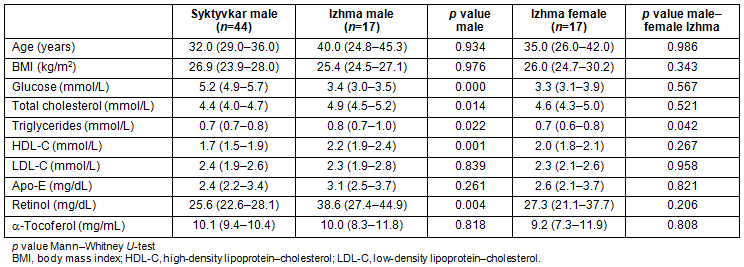
In the urban group, 24% of respondents reported smoking daily, and 33% of respondents were regular alcohol consumers (at least two times per week). There were more men in the reindeer herder group who were smokers (59%) and alcohol consumers (65%). Of the women in this group, only 12% were smokers and 12% were alcohol consumers. The average values for the Izhma group (both men and women) were 36% smokers and 39% alcohol drinkers. No significant differences in the blood biochemical indices were found between the male and female reindeer herders except in the plasma triglyceride values (p=0.042). In men, the average plasma triglyceride value was 0.8 mmol/L (0.7-1.0), and in women, the average was 0.7 mmol/L (0.6-0.8) (Table 1).
Significantly lower levels of plasma glucose (p<0.001) were observed in the male reindeer herders than in the men in the urban group. Significantly higher levels of total cholesterol (p=0.014), triglycerides (p=0.022) and high-density lipoprotein-cholesterol (HDL-C) (p=0.001) were observed in the male reindeer herders in comparison with the male urban citizens. Additionally, higher plasma levels of the fat-soluble vitamin retinol were found in male reindeer herders (p=0.004) (Table 1).
Significant differences in total FA levels (p=0.006) were found between the Izhma and Syktyvkar men (Fig1). In the male reindeer herders in the Izhma group, the total FA levels varied from 2.8 to 9.1 mmol/L, but the average value of total FAs (4.5±1.6 mmol/L) was lower than in the urban group and the reference standard16.
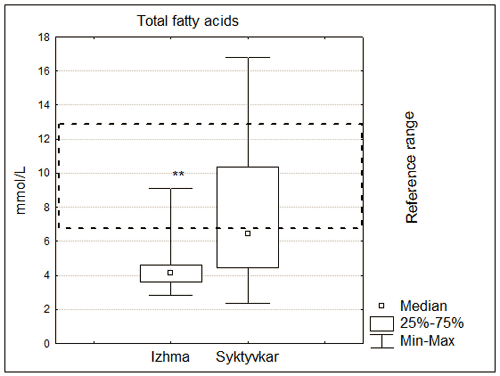
Figure 1: Levels of plasma fatty acids in total lipids of Izhma reindeer
herders and residents of Syktyvkar. **Statistically significant at p=0.006.
Analysis of the FA profile of the Izhma group showed a significant difference with respect to the Syktyvkar group (Table 2). In comparison with the urban inhabitants, higher levels of PUFA n-3 (p<0.001) (EPA and DHA) and n-7 palmitoleic acid (p<0.001) were found in the blood plasma of the inland reindeer herders. Additionally, lower levels of n-6 linoleic acid were observed in the men in the Izhma group (p=0.003). The average value of the n6/n3 index in the Izhma group was significantly lower than in the Syktyvkar group (p<0.001) (Table 2). The participants from the Syktyvkar group had an average n6/n3 index of 12.4. No significant differences in FA profiles were found between the male and female reindeer herders (Table 2). A positive correlation was found between n-3 PUFA levels in total blood lipids and age (EPA - rs=0.47; p=0.005 and DHA - rs=0.47; p=0.006) in the reindeer herder group.
Table 2: Plasma total fatty acids of reindeer herders (Izhma region) and
urban inhabitants (Syktyvkar) of Russian European North/median (25-75%)
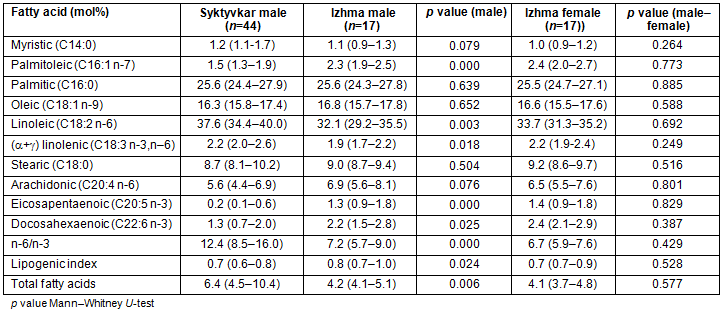
Analyses of the lipogenic index showed the C16:0/C18:2 values to be significantly higher among the residents of the Izhma region than among the inhabitants of Syktyvkar (p=0.024). The reindeer herders of Izhma had a lipogenic index of 0.78, whereas that of the residents of Syktyvkar was 0.68 (Fig2).
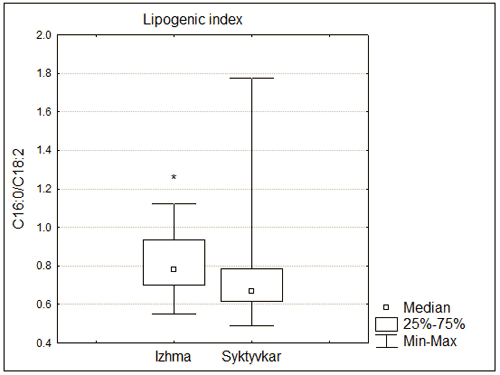
Figure 2: Lipogenic index of Izhma reindeer herders and
residents of Syktyvkar. *Statistically significant at p=0.024.
The nutrition assessments showed that the respondents in both groups were not vegetarians (Table 3). In total, 83% of the participants in the Izhma group and 54% of the Syktyvkar group were found to eat more than three meals per day. A comparison of the nutritional habits revealed an increased consumption of fish (p<0.001), reindeer meat and fat (p<0.001), white bread (p=0.033), macaroni (p<0.001) and eggs (p=0.004) by the reindeer herders than by the urban citizens. In addition, participants in the urban group reported higher consumption of fruits (p<0.001), butter (p=0.013), cultured milk foods (p=0.010) and vegetables (p=0.009) than participants from the reindeer herder group. All participants in the reindeer herder group described their fish consumption as sufficient. Among reindeer herders, fish made up 50% of the diet of 36% of participants. On average, respondents in the Izhma group consumed 213 g of fish per day (according to the consumption frequency and dish size data). Fifty percent of the participants in the Syktyvkar group reported their frequency of fish consumption as 'never or less than one time in a month'. Only 36% of respondents in that group described their fish intake as sufficient. According to questionnaire data, in the Syktyvkar group, fish made up 50% of the total diet of 8% of participants. The average daily consumption of fish of all types by the Syktyvkar group respondents was 18 g/day.
Table 3: Frequency of consumption of different products among
reindeer breeders (Izhma region, n=26) and urban citizens (Syktyvkar, n=44)
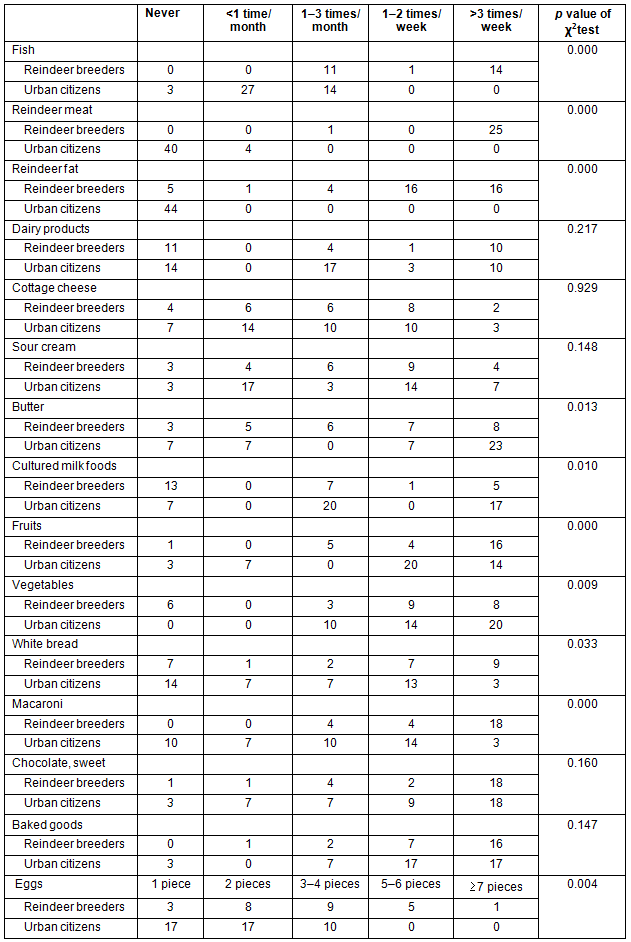
Discussion
Studying the health in a population of Izhma reindeer herders is complicated due to territorial isolation and remoteness.
The lipid levels in the blood plasma of European Russia residents are comparable to the values of the residents of other northern regions1,17-19. The levels of total FAs in the blood plasma observed in the present study were at the lower border of the reference range (Fig2)16. In the severe northern conditions, FAs and their derivatives are important energy substrates. According to the literature, exposure to the cold activates lipid oxidation in humans20. The climatic conditions of the North may increase the lipolysis and β-oxidation of FAs, particularly due to the increased activity of hypophysis-thyroid gland system in Northerners17,21.
The lowest levels of total FAs were found in the reindeer herders. In comparison with other northerners, they maintain a traditional lifestyle and therefore have significant physical activity and spend large amounts of time outdoors in severe natural climatic conditions. Apparently, these factors cause greater activation of lipolysis and β-oxidation of FAs22 and a higher activity of lipogenesis among the reindeer herders of Izhma (Fig2). Strong positive correlations between the lipogenic indices and the levels of a number of plasma FAs were observed in reindeer herders and urban inhabitants. The lipogenic index in Izhma reindeer herders correlated with the levels of saturated palmitic acid (rs=0.861; p<0.001), monoenoic palmitoleic (rs=0.657; p<0.001), oleic (rs=0.639; p<0.001) and linoleic acids (rs=-0.950; p<0.001). In the Syktyvkar group, the lipogenic index correlated with saturated FAs (C16:0 rs=0.913; p<0.001, C18:0 rs=0.400; p<0.010), monoenoic (C16:1 rs=0.517; p<0.001; C18:1 rs=0.340; p<0.050) and linoleic acids (rs=-0.930; p<0.001).
In the course of the study, significant differences in the FA profiles in the Indigenous inhabitants of the Russian European North with different lifestyles and types of nutrition were found. In comparison with Syktyvkar residents, the reindeer herders of Izhma had higher n-3 PUFA (EPA and DHA) levels in the blood plasma lipids (Table 2).
It is known that the residents of coastal areas (the Inuits and inhabitants of Greenland and Chukotka) have FA profiles with increased n-3 PUFA, unlike inland inhabitants1,3,6,7. These differences are caused by the consumption of food rich in n-3 PUFAs (seal meat and whale meat)3. Inland reindeer herders who migrate along the Pechora River were studied in the present work. Their diets mostly consisted of freshwater fish (syrok, Siberian whitefish and pike) and did not include fat or the meat of sea mammals or other seafood. Residents of the Russian European North living in coastal regions consumed from 27.1 g/day (Nelmin-Nos) to 48.8 g/day (Arkhangelsk) of fish on average23. The consumption of fish in the Izhma group was higher (average 213.0 g/day according to data from this study), which presumably caused more beneficial lipid profiles in reindeer herders in comparison with urban inhabitants.
A positive correlation between food PUFA levels and PUFA levels in blood5,24 has been observed. Hence, an analysis of the correlations between individual levels of FAs and intake of different food components was carried out. A negative correlation between plasma retinol and α-tocopherol levels and fish consumption (p<0.010 and p<0.050, respectively) was found. The ratio of n-6/n-3 in Indigenous people's diets has been used as an indicator of dietary Westernization, with higher ratios indicating lower consumption of traditional foods25. The ratio of n-6/n-3 in the Izhma reindeer herders was lower (median value 6.9) than the ratio in the comparison group, but was still in the recommended range26.
A positive correlation between n-3 PUFA levels in the total lipids of blood plasma and the age of reindeer herders was found. It shows that eating habits change inside the group (Table 3). The obtained data confirmed the results of previous studies that demonstrated correlations between n-3 EPA and DHA in blood phospholipids and age, taking into consideration nutrition habits3,27. Presumably, it may be caused by more frequent consumption of traditional foods rich in n-3 FAs in groups of greater age, or with an excessive consumption of 'Westernized' food by younger people3,27.
Main findings
Despite the high concentrations of n-3 PUFA in the blood plasma of inland reindeer herders, the levels of essential linoleic acid (LA; C18:2 n-6) were higher in urban inhabitants (Table 2). These differences may also be caused by nutritional habits. After analysis of the nutritional habits, no significant differences in sunflower seed oil consumption were found between the two groups (p=0.367). Additionally, 58% of respondents in the Izhma group and 70% in Syktyvkar group mentioned sunflower oil when answering the following question 'What do you dress salads with?' In addition, linoleic acid may be metabolized faster in reindeer herders due to its involvement in free-radical oxidation in humans28 or its role as a primary substrate in the synthesis of arachidonic acid9. Linoleic acid derivatives have also been found to be involved in the mechanisms of fat accumulation regulation29.
A higher percentage of endogenous monoenoic palmitoleic acid (C16:1 n-7) in the blood plasma of reindeer herders in comparison with urban inhabitants is of great interest. Increased levels of this acid in cholesterol esters and phospholipid fractions of plasma among inhabitants of the North were previously described6. The level of palmitoleic acid, which is a product of endogenous lipogenesis, correlates with obesity, insulin levels30 and high concentrations of plasma glucose31. Thus, it may be utilized as an independent marker of triglyceridemia and abdominal obesity in humans32,33. The level of C16:1 n-7 in total plasma lipids increases with age, which may be a result of different levels of insulin resistance in the young and the elderly34. However, a correlation between C16:1 n-7 in the blood plasma of reindeer herders and age was not found (rs=0.20; p=0.260). Additionally, no correlations between palmitoleic acid levels and blood glucose levels (rs= -0.24; p=0.260), BMI (rs= 0.11; p=0.560) and the frequency of consumption of various types of food were found.
Earlier studies indicated that hepatic de novo lipogenesis and FA desaturation are highly sensitive even to short-term dietary changes; for example, a high-carbohydrate diet14. According to the data from the present study, reindeer herders had increased consumption of the high-carbohydrate products white bread and macaroni. It is assumed that higher lipogenesis index values in the reindeer herder group may be caused by this increased carbohydrate consumption.
A significant positive correlation between lipogenic index and concentrations of palmitoleic acid (p<0.001) was demonstrated in both groups. It was assumed not to be merely a statistical phenomenon but proof that the plasma palmitoleic acid level may serve as additional marker of lipogenesis in humans.
Limitations of study design
A number of challenges were faced during this study. The working schedule of reindeer herder crews and the logistics of the Izhma region severely limited access to adult reindeer herders (resulting in only approximately 30% of subjects suitable for sampling being included in the sample). The questionnaire 'Seafood and the health of the people of the North' provided by the authors' AMAP scientific supervisors was not adjusted to the realities of the inland rural territories of the European North of Russia. Filling out the questionnaire took much time, and some questions were unclear and difficult to answer for the respondents.
At present, future studies in the same field are planned. It is hoped to obtain larger and more representative samples of the populations of rural regions of the Komi Republic, including reindeer herders from the Izhma district and other regions of the European North of Russia. In the future, the authors plan to adapt the nutritional questionnaire to the realities of Russia and to the characteristics of the populations (namely, the lack of seafood and seasonal migration).
What is new for rural health
The present work is the first study of inland reindeer herders (the native residents of the Russian European North practising a traditional lifestyle) of the Komi Republic's Izhma district and is one of the few studies to assess differences in lipid profiles between native Northerners with traditional and modern lifestyles. Izhma reindeer herders, when compared with urban citizens (of the city of Syktyvkar), demonstrated higher levels of essential EPA (p<0.001) and DHA (p=0.025) and non-essential palmitoleic fatty acid (p<0.001) in total plasma lipids. The plasma FA profiles in the reindeer herders who participated in the study corresponded to reference values24. The work was performed to create a basis for future studies assessing the public health of native rural populations and its interrelations with nutritional and biochemical features of the native people of the European North of Russia. In the authors' opinion, this work shows the importance of traditional nutrition for the health of rural populations. The results were presented to local communities in the Izhma district at the II conference 'Northern ethnos. Traditions and modernity' in July 2011 in Izhma.
The results of the study showed a more beneficial n-6/n-3 FA ratio in reindeer herders of the Russian European North than in urban inhabitants. Higher plasma n-3 PUFA levels (EPA, DHA) in reindeer herders who had more fish in their diet were demonstrated. In addition, inland reindeer herders showed higher palmitoleic acid levels and lower linoleic acid levels in blood total lipids than urban inhabitants. The results of the present study indicate that plasma palmitoleic acid levels may serve as additional markers of lipogenesis in studied groups. The nutritional features and environmental conditions were assumed to have the greatest effects on plasma FA profiles and lipid metabolism in the Indigenous inhabitants of Russian European North.
Acknowledgements
This study was supported by the Secretariat of the Arctic Monitoring and Assessment Program as well as AMAP (No. 29-2009), Program of UD RAS, project No. 12-C-4-1021 and No. 12-C-4-1026, Russian Foundation for Humanities No. 10-06-41602. The authors thank all research staff and participants.
References
1. Deutch B, Dyerberg J, Pedersen HS, Asmund G, Moller P, Hansen JC. Dietary composition and contaminants in north Greenland, in the 1970s and 2004. Science of the Total Environment 2006; 370(11): 372-381.
2. Ebbesson OE, Tejero ME, López-Alvarenga JC, Harris WS, Ebbesson LOE, Devereux RB, et al. Individual saturated fatty acids are associated with different components of insulin resistance and glucose metabolism: the GOCADAN study. International Journal of Circumpolar Health 2010; 69(4): 344-351.
3. Zhou YE, Kubow S, Egeland GM. Highly unsaturated n-3 fatty acids status of Canadian Inuit: International Polar Year Inuit Health Survey, 2007-2008. International Journal of Circumpolar Health 2011; 70(5): 498-510.
4. Loring PhA, Gerlach SC. Food, culture, and human health in Alaska: an integrative health approach to food security. Environmental Science & Policy 2009; 12: 466-478.
5. Baylin A, Kim MK, Donovan-Palmer A, Siles X, Dougherty L, Tocco P, et al. Fasting whole blood as a biomarker of essential fatty acid intake in epidemiologic studies: comparison with adipose tissue and plasma. American Journal of Epidemiology 2005; 162(4): 373-381.
6. Deyberg J, Bang HO, Hjorne N. Fatty acids composition of the plasma lipids in Greenland Eskimos. American Journal of Clinical Nutrition 1975; 28: 958-966.
7. Parkinson AJ, Cruz AL, Heyward WL, Bulkow LR, Hall D, Barstaed L, et al. Elevated concentrations of plasma omega-3 polyunsaturated fatty acids among Alaskan Eskimos. American Journal of Clinical Nutrition 1994; 59: 384-388.
8. Babenko LG, Bojko ER. Ethno-social features of obesity and diabetes mellitus morbidity among residents of Russian European North. Izvestia of Komi Science 2010; 2: 32-39.
9. Arab L. Biomarkers of fat and fatty acid intake. Journal of Nutrition 2003; 133(3): 925-932.
10. Statisticheskiy echzhegodnic Republik Komi (RUS). 2009: Stat.sb./Komistat., 2009, 450 pp. Available: http://komi.gks.ru/public/DocLib5/Forms/Items.aspx.
11. Thompson FE, Byers T, Kohlmeier L (guest eds). Dietary assessment resource manual. Journal of Nutrition 1994; 124(11): 2245-2317.
12. Folch J, Lees M, Stanley G. A simple method for the isolation and purification of total lipids from animal tissues. Journal of Biological Chemistry 1957; 226: 497-509.
13. Lillington JM, Trafford DJ, Makin HL. A rapid and simple method for the esteri?cation of fatty acids and steroid carboxylic acids prior to gas-liquid chromatography. Clinica Chimica Acta 1981; 111: 91-98.
14. Chong MF, Hodson L, Bickerton AS, Roberts R, Neville M, Karpe F, et al. Parallel activation of de novo lipogenesis and stearoyl-CoA desaturase activity after 3d of high-carbohydrate feeding. American Journal of Clinical Nutrition 2008; 87: 817-823.
15. WHO Expert Consultation. Appropriate body-mass index for Asian populations and its implications for policy and intervention strategies. Lancet 2004; 363: 157-163.
16. Tietz NW. Fundamentals of clinical chemistry. Philadelphia: WB Saunders Company, 1987.
17. Tkachev AV, Bojko ER, Ramenskaya EB. Endocrine status and plasma lipids in inhabitants of the northern European part of the USSR. Arctic Medical Research 1991; 50(6): 148-151.
18. Belanger MC, Dewailly E, Berthiaume L, Noel M, Bergeron J, Mirault M-E, et al. Dietary contaminants and oxidative stress in Inuit of Nunavik. Metabolism - Clinical and Experimental 2006; 55: 989-995.
19. Valera B, Dewailly E, Anassour-Laouan-Sidi E, Poirier P. Infuence of n-3 fatty acids on cardiac autonomic activity among Nunavik Inuit adults. International Journal of Circumpolar Health 2011; 70(1): 6-18.
20. Haman FO, Peronnet FO, Kenny G, Massicotte D. Effect of cold exposure on fuel utilization in humans: plasma glucose, muscle glycogen, and lipids. Journal of Applied Physiology 2002; 93: 77-84.
21. Bojko ER, Evdokimov VG, Potolitsyna NN, Kaneva AM, Varlamova NG, Kochan TI, et al. The pituitary-thyroid axis and oxygen consumption parameters under the conditions of human exposure to chronic cold in the North. Human Physiology 2008; 34(2): 93-98.
22. Vallerand AL, Zamecnik J, Jones PJH, Jacobs I. Cold stress increases lipolysis, FFA Ra and TG/FFA cycling in humans. Aviation Space and Environmental Medicine 1999; 70: 42-50.
23. Petrenya N, Dobrodeeva L, Brustad M, Bichkaeva F, Menshikova E, Lutfalieva G, et al. Fish consumption and socio-economic factors among residents of Arkhangelsk city and the rural Nenets autonomous area. International Journal of Circumpolar Health 2011; 70(1): 46-58.
24. Hodson L, Skeaff CM, Fielding BA. Fatty acid composition of adipose tissue and blood in humans and its use as a biomarker of dietary intake. Progress in Lipid Research 2008; 47: 348-380.
25. Simopoulos AP. The importance of the omega-6/omega-3 fatty acid ratio in cardiovascular disease and other chronic diseases. Experimental Biology and Medicine 2008; 233(6): 674-688.
26. Joint FAO/WHO Expert Consultation on Fats and Fatty Acids in Human Nutrition, Interim Summary of Conclusions and Dietary Recommendations on Total Fat & Fatty Acids. Geneva: WHO 2008.
27. Crowe FL, Skeaff CM, Green TJ, Gray AR. Serum fatty acids as biomarkers of fat intake predict serum cholesterol concentrations in a population-based survey of New Zealand adolescents and adults. American Journal of Clinical Nutrition 2006; 83: 887-894.
28. Richard D, Kefi K, Barbe U, Bausero P, Visioli F. Polyunsaturated fatty acids as antioxidants. Pharmacological Research 2008; 57(6): 451-455.
29. Choi YJ, Kim YC, Han YB, Park Y, Pariza MW, Ntambi JM. The trans-10,cis-12 isomer of conjugated linoleic acid downregulates stearoyl-CoA desaturase gene expression in 3T3-L1 adipocytes. Journal of Nutrition 2000; 130: 1920-1924.
30. Stefan N, Kantartzis K, Celebi N, Staiger H, Machann J, Schick F, et al. Circulating palmitoleate strongly and independently predicts insulin sensitivity in humans. Diabetes Care 2010; 33: 405-407.
31. Lindgarde F, Vessby B, Ahren B. Serum cholesteryl fatty acid composition and plasma glucose concentrations in Amerindian women. American Journal of Clinical Nutrition 2006; 84(5): 1009-1013.
32. Okada T, Furuhashi N, Kuromori Y, Miyashita M, Iwata F, Harada K, Plasma palmitoleic acid content and obesity in children. American Journal of Clinical Nutrition 2005; 82(4): 747-750.
33. Paillard F, Catheline D, Duff FL, Bouriel M, Deugnier Y, Pouchard M, et al. Plasma palmitoleic acid, a product of stearoyl-coA desaturase activity, is an independent marker of triglyceridemia and abdominal adiposity. Nutrition, Metabolism & Cardiovascular Diseases 2008; 18(6): 436-440.
34. Asciutti-Moura LS, Guilland JC, Fuchs F, Richard D, Klepping J. Fatty acid composition of serum lipids and its relation to diet in an elderly institutionalized population. American Journal of Clinical Nutrition 1988; 48(4): 980-987.




